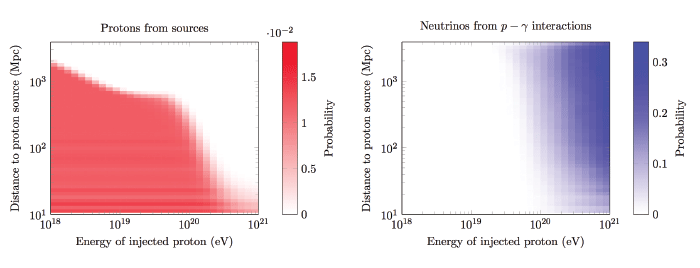Charts created by Amy Connolly at The Ohio State University show the complementarity of cosmic rays and neutrinos according to which cosmic sources they probe. Both use a flat redshift evolution and E-1 injection spectrum.
The earth and other celestial bodies are continually bombarded by extremely fast-moving, subatomic particles known as cosmic rays, gamma rays and neutrinos. Although the origin of ultra-high energy (UHE) particles (defined as above 1018 electronvolts or eV) is unknown, scientists believe that they could be created and accelerated by cataclysmic events, such as collisions between compact objects or a star falling into the black hole at the center of a galaxy.
Nearly all of the cosmic rays that originate outside of Earth’s atmosphere are the nuclei of well-known atoms, such as hydrogen and helium, stripped of their electron shells. Neutrinos also are subatomic particles, but they possess a neutral electrical charge, only interact weakly and, therefore, can pass through normal matter unimpeded.
Astrophysicists can use information gleaned from these elusive particles to learn more about the universe and even about particle physics. A study led by Amy Connolly, Ph.D., assistant professor of physics at The Ohio State University, leveraged Ohio Supercomputer Center resources to evaluate the complementarity of cosmic rays and neutrinos as a source of information about the universe’s most extreme particle accelerators.
“Cosmic rays above 1019.5 eV cannot have originated from more than approximately 100 megaparsecs from Earth due to the onset of the GZK process,” said Connolly. The Greisen–Zatsepin–Kuzmin (GZK) process represents the slowing and bending of cosmic rays over long distances due to microwave background radiation. “Neutrinos, however, can travel cosmological distances unabated and would be our only view of the distant universe above the GZK cutoff.”
Connolly’s group utilized open-source CRPropa, as well as other simulation and analysis software, to calculate the energy spectrum of protons, gamma rays and neutrinos observed at Earth. They analyzed protons produced at energies between 1016 eV and 1025 eV and at distances up to 3 gigaparsecs.
They quantified the implications of current cosmic ray measurements and neutrino constraints on parameters characterizing the UHE sources, subject to existing gamma ray measurements. The group measured the spectral index below 1020 eV and the overall normalization of source emission. Neutrinos provide the ultimate acceleration energy (Emax) and are unique probes of redshift evolution, or the dependence of the density of sources on distance. For the first time, they constrained Emax based on the non-observation of UHE neutrinos by current experiments and quantified the sensitivity of future experiments to measuring Emax and the source evolution.
Project Lead: Amy Connolly, The Ohio State University
Research Title: The complementary nature of cosmic rays and neutrinos in constraining UHE astrophysics
Funding Source: National Science Foundation
Website: http://physics.ohio-state.edu/directory_pages/detail.php3?id=2676

